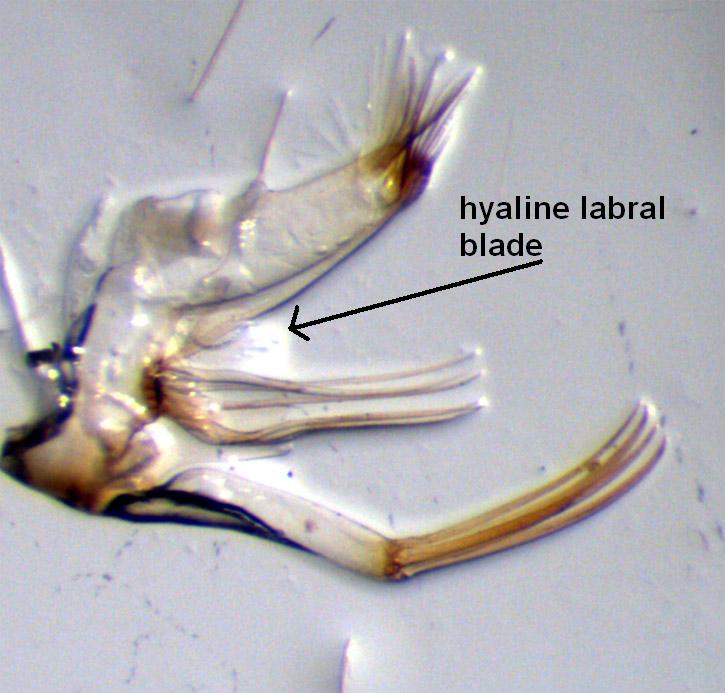Diptera.info :: Identification queries :: Diptera (eggs, larvae, pupae)
|
Chaoborus obscuripes larva
|
|
| Cranefly |
Posted on 21-01-2010 10:29
|
|
Member Location: Shachovskaya Posts: 647 Joined: 17.09.08 |
I took these larvae from aquarium fishes at Christams night to try to make photo. I hope it is Chaoborum crystallinus, but need confirmation. Cranefly attached the following image:  [129.11Kb] Edited by Cranefly on 10-03-2011 09:32 |
|
|
|
| atylotus |
Posted on 21-01-2010 11:22
|
|
Member Location: Amsterdam, NL Posts: 1166 Joined: 29.05.09 |
to be sure you need to study the labral blade, the dorsal proces and the anal tubules. You can see the mandible very good and it is definitely NOT C. flavicans. To me the dorsal proces is short (in pallidus and obscuripes) and not protruded into a long pointed lobe (as in C. crystallinus and flavicans), the anal tubules seems as if they are rounded att he end (as in C. crystallinus and C. obscuripes) and not pointed (as in C. flavicans and C. pallidus). I can't really see the labral blade. If the labral blade is needle-like thin than it is C. pallidus, if it is a flattened plate then another species. In that case you have to check if the labral blade has a S-shaped edge with a long pointed end and wit honly minute smaller teeth along its edge (C. crystallinus) or is more or less rounded with many coarse teeth, especially at the end (as in C. obscuripes).
atylotus attached the following image:  [64.99Kb] |
|
|
|
| Cranefly |
Posted on 21-01-2010 11:27
|
|
Member Location: Shachovskaya Posts: 647 Joined: 17.09.08 |
Thank you, Atylotus. I'll try to study all these characters. |
|
|
|
| Cranefly |
Posted on 21-01-2010 11:46
|
|
Member Location: Shachovskaya Posts: 647 Joined: 17.09.08 |
dorsal processes short like in pallidus gradually bacoming shorter without any one protruding above, tubules long like fingers and rounded apically, as for labral blades - they are thickened basally, curved s-like basally, with very long and thin needle-like apical part - about 1,5 times as long as curved thickened basal part. Without dents. And only 2-3 of them are thickened significantly, the others thickened a little and look needle-like |
|
|
|
| Cranefly |
Posted on 21-01-2010 11:53
|
|
Member Location: Shachovskaya Posts: 647 Joined: 17.09.08 |
antenna with clear basal "depression" |
|
|
|
| Cranefly |
Posted on 21-01-2010 13:37
|
|
Member Location: Shachovskaya Posts: 647 Joined: 17.09.08 |
one more photo
Cranefly attached the following image:  [163.34Kb] |
|
|
|
| atylotus |
Posted on 21-01-2010 14:00
|
|
Member Location: Amsterdam, NL Posts: 1166 Joined: 29.05.09 |
Antenna with constriction at its base, so next to C. flavicans, C. pallidus can be excluded also. Still remains C. crystallinus and obscuripes. Labral blade seems to be broken off. As the dorsal proces is short C. obscuripes is the most likley one. |
|
|
|
| Cranefly |
Posted on 21-01-2010 16:03
|
|
Member Location: Shachovskaya Posts: 647 Joined: 17.09.08 |
Many thanks for you help. I discovered that I have better results in terrestrial larvae. Now I'll try to improve this and determine one more Chaoborus species myself. |
|
|
|
| Cranefly |
Posted on 21-01-2010 17:36
|
|
Member Location: Shachovskaya Posts: 647 Joined: 17.09.08 |
I have found labral blade at last. It is flat a little narrower than eye, about 3,5 times as long as wide, apex with incision separating oval darker lobe with a group of setae and some small teeth (possibly 2, one of them is larger) at apex. Preapical part has a group of setae too. I am away from the stereomicroscope now and can/' t make photo till Monday. |
|
|
|
| cyprinoid |
Posted on 21-01-2010 20:18
|
|
Member Location: Norway Posts: 1751 Joined: 19.06.09 |
See C. obscuripes here: http://diptera.in...d_id=26703 (Thanks again atylotus  ) )
Hyperbolizer |
| Cranefly |
Posted on 25-01-2010 10:36
|
|
Member Location: Shachovskaya Posts: 647 Joined: 17.09.08 |
I apply to your help once more. I have no figures of labral blade in the keys which I use. And can't read text on that page kindly attached to Ch. obscrupes discussion. So I attach labral blade of this creature to become sure at last ; What was it?
Cranefly attached the following image:  [168.26Kb] |
|
|
|
| atylotus |
Posted on 25-01-2010 10:58
|
|
Member Location: Amsterdam, NL Posts: 1166 Joined: 29.05.09 |
Dear Cranefly, to me it looks like C. obscuripes. The labral blade in this case is large, flat and in the apical part coarsely toothed. This is typical for C. obscuripes.
atylotus attached the following image:  [71.11Kb] |
|
|
|
| Cranefly |
Posted on 25-01-2010 11:00
|
|
Member Location: Shachovskaya Posts: 647 Joined: 17.09.08 |
Many-many thanks. I am really so glad to complete our long and productive discussion. So, I chnge the title for obscuripes!!!
Edited by Cranefly on 10-03-2011 09:33 |
|
|
|
| Jump to Forum: |













